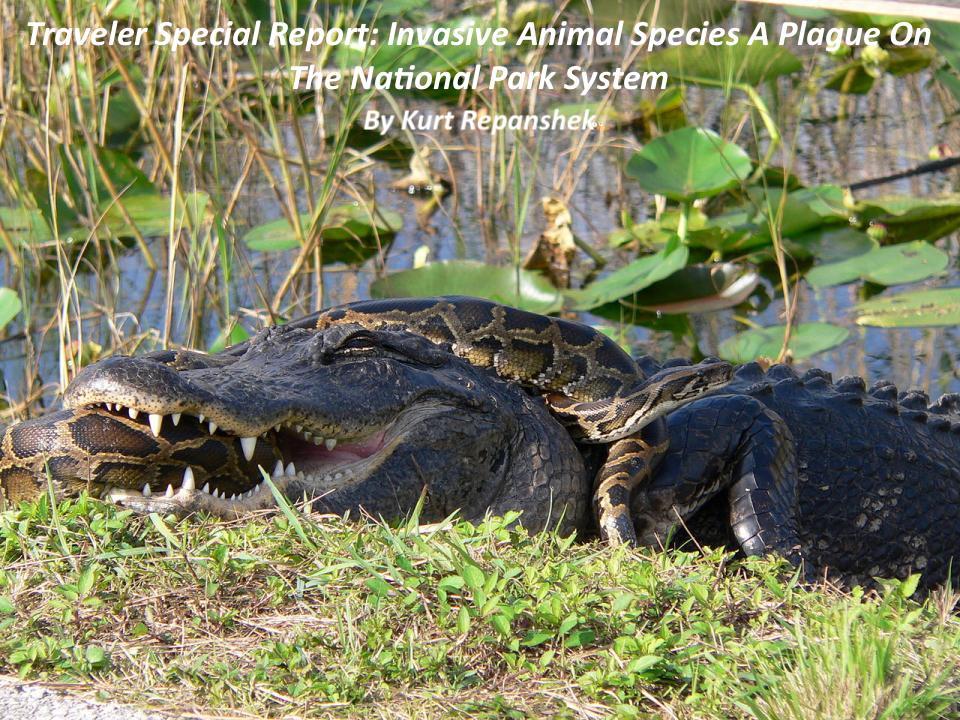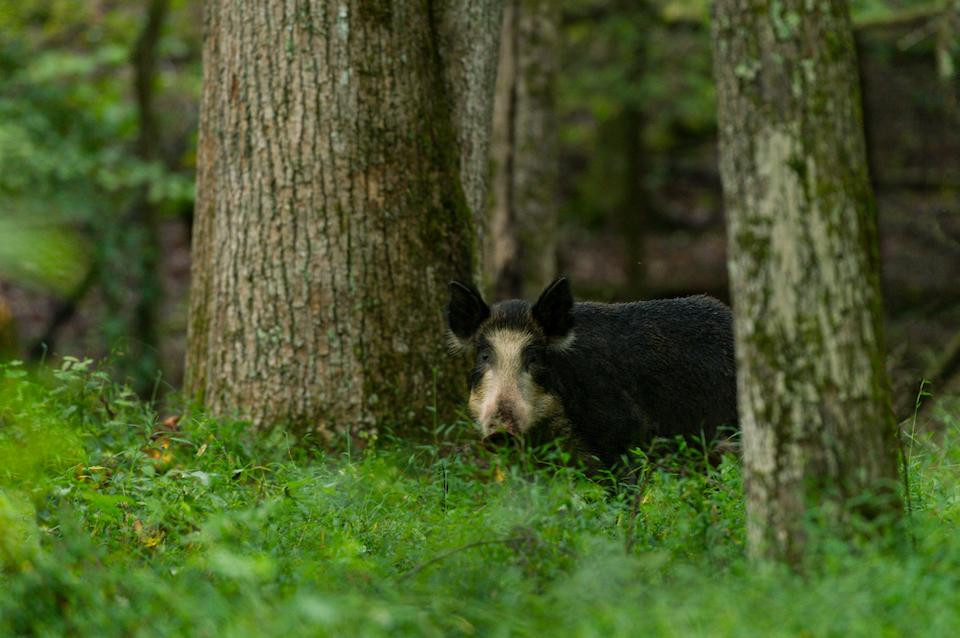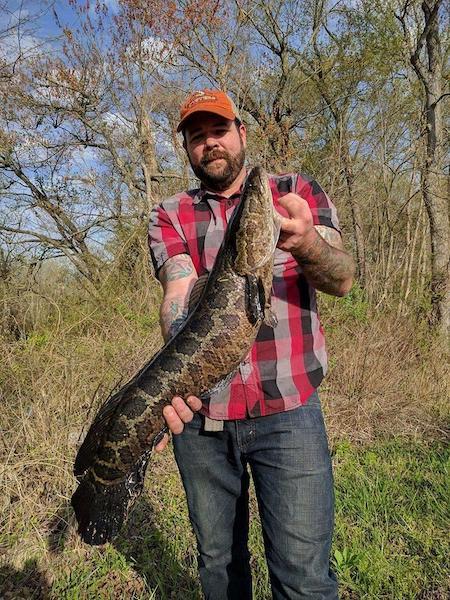
Invasive pythons battle native alligators in Everglades National Parks/NPS
There has been, for a disturbing amount of time, a slow, creeping invasion of the national parks, one arriving in the form of an ecosystem-upsetting menagerie that poses a significant threat to both native species and the very integrity of the parks.
It is an invasion on land and in the water, one that is attacking wildlife that has evolved with the landscapes. For some parks, the problem has gone beyond being an isolated problem and turned into a malevolent force that is literally impairing the very nature of the parks and some of the reasons they were set aside in the first place.
At Everglades National Park, non-native Burmese pythons and native alligators face off in eat-or-be-eaten battles. Northern snakehead fish are poised to upend the watery ecology of parks such as Prince William Forest Park and the Chesapeake and Ohio Canal National Historical Park, while lionfish threaten the marine environments of Everglades, Dry Tortugas, Virgin Islands, and Biscayne national parks. Come ashore in the Appalachians and you might encounter feral hogs that rototill vegetation in Great Smoky Mountains National Park and even pose threats to human visitors.
That small handful of invaders are part of a much larger attack on native species in the parks and their surrounding landscapes, as more than 300 invasive animal species today present an ecosystem-upsetting menagerie in the National Park System.
“Invasive animals are a major problem in the national parks. We have 419 national parks right now, and when you look across those parks it appears that about half of them have issues with non-native animals, with over 1,400 populations of those invasive animals and more than 300 species,” says David Hallac, the superintendent of National Parks of Eastern North Carolina who was a co-author on a recent paper that decried the incredible tide of invasive species in the park system.
For a park system with an estimated $12 billion backlog of maintenance needs, for the National Park Service that is hobbled with a budget that has struggled to keep pace not just with the maintenance backlog but with handling more than 310 million visitors a year at a time of declining park staffs, the growing invasion of non-native animal species is an added managerial nightmare for parks.
We assert that the global threat of invasive animals substantially undermines the National Park Service mission. ... Engagement by NPS leadership to create a systemwide approach to address the challenge of managing invasive animals can magnify existing individual cases of success into a program of much broader scale success. The integrity of U.S. National Parks depends on it. -- The Unaddressed Threat of Invasive Animals In U.S. National Parks.
“It definitely is a very daunting task," agreed Jennifer Sieracki, the Park Service's invasive animal species coordinator. "We are dealing with a number of species that actually do a lot of damage to our parks. For instance, feral swine are found in a number of our parks. It is one of the more common invasive animal species that we are finding. And it is very damaging due to the rooting that it does in our parks. Its removed a lot of vegetation from the important ecosystems that we manage every day. And it also affects some native animal species as well."

Wild hogs are a problem in a number of national parks, including Great Smoky Mountains National Park/Courtesy of Bill Lea
Hog Wild In The Smokies
Wild hogs that root through the backcountry of Great Smoky Mountains National Park can be traced to 1912, when they arrived at a private hunting ground outside the park. Apparently the hunters couldn’t keep up with the prey, for eight years later more than 100 pigs were said to have escaped the preserve.
The swine quickly found the mountains to be close to hog heaven, thanks to the acorns that fall from white oaks, the once-bountiful chestnut trees, and the hickory nuts, not too mention just about anything else they consider edible, whether that be insects, salamanders or bird eggs. These rooting and wallowing hogs threaten natural ecological communities. They'll eat just about anything, including Jordon’s Salamanders, which are found only in the park, and the roots and foliage of wildflowers that often take years to mature and bloom.
Burmese pythons are an even greater problem at Everglades and nearby Big Cypress National Preserve in South Florida, as these huge constrictors have been decimating such native species as rabbits, deer, raccoons, opossum and bobcats. Eight years ago the National Academy of Sciences in effect indicted the pythons for "the loss, the crash of the small mammal population," Everglades Superintendent Pedro Ramos said last week.
"We continue to see that decline. We continue to notice the absence of animals like rabbits and raccoons throughout the landscape," he went on. "And while we may not fully understand the direct correlation between the snake itself, the python, and that decline, we do know for sure that the python invasion has had a lot to do with it.”
But the pythons, which also take on alligators on occasion, aren't the only invasive species in Everglades and Big Cypress. Also present are monitor lizards; Argentine black and white tegu, another lizard that can grow to more than 4 feet in length and eat small birds, eggs, and small vertebrates; green iquanas; and lionfish.
Parklands in South Florida are particularly ripe for invaders, according to Hallac.
“There are so many different non-native species down in South Florida due to the tropical environment and the connectivity, in particular, of all the water bodies, with canals and lakes and streams," he said. "It’s a hard place to stop the movement of those animals. But for sure, Burmese pythons to some degree have become the poster child of invasive animals in the U.S."
At Defenders of Wildlife, Elizabeth Fleming, the organization's senior Florida representatve, said the invasion is impacting efforts to help native species overcome their "endangered" or "threatened" status.
"Florida’s national parks serve as essential habitat for more than 120 federal and state endangered and threatened species. Sadly, invasive species are further straining these animals’ already-difficult fight for survival," she said. "The Burmese python, for instance, is consuming many endangered species, including critically-endangered Key Largo woodrats and various wading birds. Even panther kittens are vulnerable, coming at a time when Florida panthers are already facing serious threats, including habitat destruction, vehicle collisions and a mysterious neuromuscular disorder. Without immediate action, invasive species will continue to dismantle these ecosystems, permanently altering these iconic lands."
In her role, Sieracki's task is to develop an agency-wide program for dealing with the invaders. As of yet, though, the Park Service has no master priority list for attacking invasive animal species. It could be challenging to create one due to the many invaders and the specific threats they pose to the parks where they've been found. Here's a short list of parks and some of their invaders:
* Yellowstone National Park (lake trout in Yellowstone Lake);
* Prince William Forest Park and the Chesapeake and Ohio Canal National Historical Park (Northern snakehead, a fish species);
* War in the Pacific National Historical Park (African land snails);
* Glen Canyon National Recreation Area (quagga mussels);
* Big Thicket National Preserve (feral hogs);
* Cape Hatteras National Seashore (feral cats and red fox);
* Acadia National Park (Asian shore crab).
* Virgin Islands National Park (mongoose, donkeys, hogs, rats, lionfish)
* Death Valley National Park (burros)
"There are also a number of species that people would not have realized are invasive," Sieracki said, "including some common birds, European Starlings, House Sparrows, and Rock Doves (aka the common pigeon), some species of fire ants, including red imported fire ants, tropical fire ants, and little red fire ants, some species of mosquitoes, including Asian tiger mosquitoes, Asian rock pool mosquitoes, and yellow fever mosquitoes, (and) feral species, including domestic cats and dogs, cattle, sheep, and goats."
Invasive species in parks that some might object to removing include feral horses at Theodore Roosevelt National Park as well as Cape Lookout and Cumberland Island national seashores.

Northern snakeheads, native to Asia, were spotted in the eastern United States in 2002. They are a predatory species that threatens native fisheries/Chad Wells
A Staggering Problem
The latest tally by the Park Service shows there were 1,428 populations of 308 invasive animal species reported in the National Park System this year. Of that total, 25 percent of the invasive animal species are accounted for in park management plans; 11 percent are reported as being "under control".
"Typically the parks will decide what they would like to manage, and also those things which they have decided are part of the resource that they would actually like to keep," explained Sieracki.
Getting support from a central office such as Sieracki's when it comes to managing the invaders is key, said Hallac.
"When a park manager, a park’s resource manager, or scientist is looking at potentially an entire portfolio of invasive animals -- take a place like Everglades, for example, or even Cape Hatteras, where we have many different nonnative mammals that are affecting nesting shorebirds -- it’s hard to know which one should we focus on. Sometimes it’s just not feasible to focus on all of them," he said. "So managers are having to have to look at lots of different factors and develop decision support tools that look at a variety of different criteria."
Elaine Leslie, who was the Park Service's Chief of Biological Sources before retiring earlier this year, said the agency needs to get more aggressive, tenacious, and willing to turn to new technologies in the battles.
"We are very risk-averse," she said of the Park Service. "We don’t want unintended consequences of what we do, but we could try new technology and approaches. It’s almost 2020, we need to not do things the way we’ve always done them."
Should the agency "continue to whack away at this for the next 50 years" following the way it has traditionally battled invasive species, or "how ‘bout we try something different?" said Leslie. "Look at Everglades. You can hunt as many constrictors as you want, but when you have something that is such a fast and prolific producing animal as a boa, you’re never going to eradicate them, you’re never going to get them down to where they’re not causing impairment, so why not try something different?"
"Something different" could focus on genomic biology, understanding the complete DNA of an organism and how it functions and evolves, to synthetic biology, in which organisms are altered for a specific purpose, such as creating a population of sterile mosquitoes that could be used to eventually remove the insects from an area.
“It’s just time for the Park Service and Fish and Wildlife Service and others to not be so afraid of new approaches and technologies, because you’re not just losing the battle in Everglades. You’re losing the ecosystem, the very reason that the park was established," warned Leslie.
While the wildlife biologist maintains that some in the Park Service "are afraid to use the word 'impairment'" of park resources when it comes to this invasion, Superintendent Ramos is not one to shy from it.
"There’s a lot of other problems, and together they really compound the situation of the problem," he said. "To respond to your question, yes, I believe that the python is having impairment effects on the landscape down here. Not just in Everglades National Park, but beyond.
"Our science group is telling us that they don’t have a lot of hope that we will ever be able to completely eradicate the python, python, for instance, out of the landscape," said Ramos, added, however, that "we’re certainly not going to throw in the towel."
Eradicating some of these species just might not be possible -- Everglades, for example, spans 1.5 million acres and embraces the largest subtropical wilderness in the United States -- but controlling some of the invaders might be possible.
"It definitely depends upon the species," Sieracki said. "There are certainly some species that have been around for a long time, and it would be very difficult to remove them from parks, and they may even have some cultural value at this point. And then there are those species where it is possible to eradicate them. I think that our best hope for being able to control some of these species is to work both with formal and informal partnerships with local state, federal, tribal entities, and also the local communities near the parks in order to manage them, because managing them on our own is very difficult.”
Hallac agreed.
“Can invasive animals be removed? The answer is yes they can be removed. Can they be controlled? That becomes a slightly harder question," he said. "And when I say 'controlled,' I mean their populations brought to a level where they’re no longer having a measurable or significant impact on the native ecosystem. The third question, which is really the hardest question, is can they be eradicated?
"As you go through those questions, from removal to control to eradication, the prospects become more and more difficult," Hallac added. "But overall, actually, parks have been able to achieve to some degree success for all three of those categories. In almost all cases there can be some removal of the invasive animal. Control is typically the goal. You want to try to find some way to make that invasive animal ecologically insignificant."
Ramos said that in his park, "We need to focus on keeping up the pressure. We need to focus on keeping up the research so that we can increase, for instance, our detection techniques, and then we also need to continue restoring the Everglades, because a healthy Everglades in the long run is what’s going to keep this place as resilient as possible to fend off all of these threats, including the threat of the invasive species of animals and plants.”
The hard-to-answer question is: Does the Park Service have the financial and human resources to significantly tackle the problem of invasive animal species? According to the recent paper, in 2012 the Park Service spent $9.6 million trying to control invasive species. What that number doesn't reflect is the dollar cost of the resource damage being done by the invaders.
"If you can prevent them from coming in in the first place -- which might be costly by the way, in and of itself -- the cost associated with that is likely to be an order of magnitude lower than the cost associated with trying to control or eradicate an established population," Hallac said. “So it definitely can be expensive, but in some cases it’s worth it. And, interestingly, we tend to think very negatively about invasive animals, because we’re talking about removing them, or killing them, or relocating them.
"In fact, the problem is more related to management and recovery of the native animals in that ecosystem. So it really depends on which way you look at it," he said. "In many cases, the goal is really to allow the native species to flourish, and that may only require some level of control.”






Comments
The invasive species of animals need to be eradicated even if that means killing them. Pythons are cold blooded and need heat to live, it's a great pity these snaKes cannot be under total control. Wild hogs in the Smokey Mountains destroy habitats for other animals need to be managed so their number is very much smaller. The Black Bear, Elk and deer are icons of the smokey mountains. More rangers are needed to combat the problem.
i think florida has to invent a computer driven water vehicle that can float like a boat and also drive on land. on these vehicles will be a robotic hand or claw and a circular saw blade. the claw or hand will hold the snake and the circular saw will cut it in half or 3 pieces. these vehicles should be big about 6-10 feet in length , weigh about 250 lbs each, travel in groups of 2-3 and seek out the snakes and monitor lizards and kill them. imagine two of these 250 lbs vehicles cornering a snake, both having a robotic claw holding the snakes or lizards and each of their circular saws cutting them to pieces. they are no longer threats one by one until there are no more. it can be done, we have the tech in america to make it a reality.
Teenage fantasies of robotic killing machines aside, the best way is to catch encourage park visitors to take direct action. Most February's Florida state fish and wildlife has a python round up. That should be annual and expanded to federal lands. Making the snake head fish available to catch year round without a license. Create feral hog hunting seasons, with free butchering of culled hogs.
I am somewhat confused by this photo. Both the Alligator and Pithon are fighting for supremacy but which is winning? My bet is on the Alligator.
My bet is that both lose.